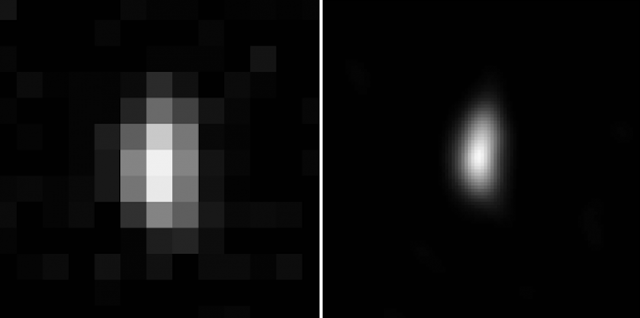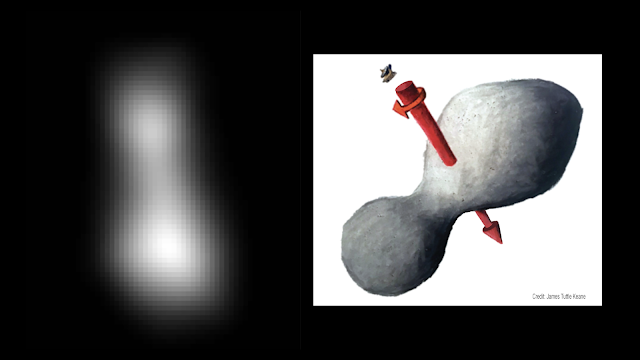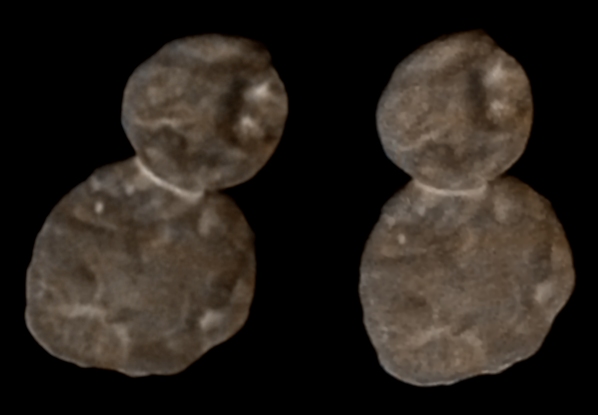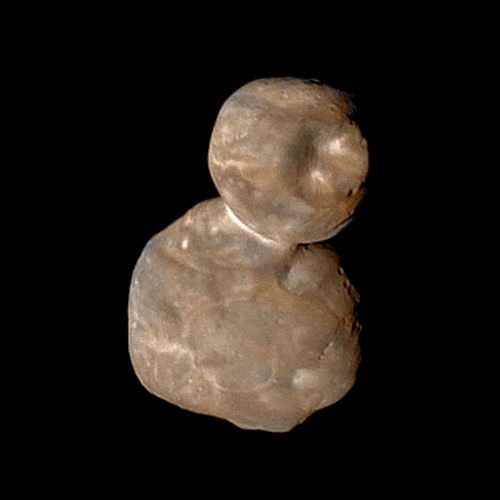It looks like you're using an Ad Blocker.
Please white-list or disable AboveTopSecret.com in your ad-blocking tool.
Thank you.
Some features of ATS will be disabled while you continue to use an ad-blocker.
share:
First more-or-less close looks at Ultima Thule: orbiterchspacenews.blogspot.com...

It's really only just a few pixels, but we can guess the approximate shape.

It looks like a bowling pin.

It's really only just a few pixels, but we can guess the approximate shape.

It looks like a bowling pin.
a reply to: wildespace
Well... better than fuzzy dice!!!
If you know what I mean...
That is so cool!! And iirc the window is 72 hours.
I hope there is more to come!!
Well... better than fuzzy dice!!!
If you know what I mean...
That is so cool!! And iirc the window is 72 hours.
I hope there is more to come!!
Preliminary science results from the flyby, for those who are intersted: arxiv.org...
Mainly discussing the shape, the surface, the colour, and a few other things.
I'm glad they noticed that the areas near the "neck" show some colour variation from the rest of the object.
I reprocessed the colour-enhanced images of Ultima Thule into this approximatly-true-colour view:

Mainly discussing the shape, the surface, the colour, and a few other things.
I'm glad they noticed that the areas near the "neck" show some colour variation from the rest of the object.
I reprocessed the colour-enhanced images of Ultima Thule into this approximatly-true-colour view:

a reply to: wildespace
It is interesting that they did not observe any dust surrounding UT. And little to no interaction with the solar wind.
I guess we'll have to wait until March to see how that paper gets fleshed out with more data!
It is interesting that they did not observe any dust surrounding UT. And little to no interaction with the solar wind.
I guess we'll have to wait until March to see how that paper gets fleshed out with more data!
originally posted by: TEOTWAWKIAIFF
a reply to: wildespace
It is interesting that they did not observe any dust surrounding UT. And little to no interaction with the solar wind.
I guess we'll have to wait until March to see how that paper gets fleshed out with more data!
That's why they called it the most pristine object visited in the Solar System. It had virtually no impacts for most of its existence, and the Sun's inflence there is extremely small.
New image from New Horizons: pluto.jhuapl.edu...
Here with colours added by me from an earlier colour image:

This image, taken during the historic Jan. 1 flyby of what's informally known as Ultima Thule, is the clearest view yet of this remarkable, ancient object in the far reaches of the solar system – and the first small "KBO" ever explored by a spacecraft.
Obtained with the wide-angle Multicolor Visible Imaging Camera (MVIC) component of New Horizons' Ralph instrument, this image was taken when the KBO was 4,200 miles (6,700 kilometers) from the spacecraft, at 05:26 UT (12:26 a.m. EST) on Jan. 1 – just seven minutes before closest approach. With an original resolution of 440 feet (135 meters) per pixel, the image was stored in the spacecraft's data memory and transmitted to Earth on Jan. 18-19. Scientists then sharpened the image to enhance fine detail. (This process – known as deconvolution – also amplifies the graininess of the image when viewed at high contrast.)
The oblique lighting of this image reveals new topographic details along the day/night boundary, or terminator, near the top. These details include numerous small pits up to about 0.4 miles (0.7 kilometers) in diameter. The large circular feature, about 4 miles (7 kilometers) across, on the smaller of the two lobes, also appears to be a deep depression. Not clear is whether these pits are impact craters or features resulting from other processes, such as "collapse pits" or the ancient venting of volatile materials.
Here with colours added by me from an earlier colour image:

new topics
-
Putin, Russia and the Great Architects of the Universe
ATS Skunk Works: 1 hours ago -
A Warning to America: 25 Ways the US is Being Destroyed
New World Order: 5 hours ago -
President BIDEN's FBI Raided Donald Trump's Florida Home for OBAMA-NORTH KOREA Documents.
Political Conspiracies: 11 hours ago
top topics
-
President BIDEN's FBI Raided Donald Trump's Florida Home for OBAMA-NORTH KOREA Documents.
Political Conspiracies: 11 hours ago, 28 flags -
A Warning to America: 25 Ways the US is Being Destroyed
New World Order: 5 hours ago, 11 flags -
Las Vegas UFO Spotting Teen Traumatized by Demon Creature in Backyard
Aliens and UFOs: 16 hours ago, 7 flags -
2024 Pigeon Forge Rod Run - On the Strip (Video made for you)
Automotive Discussion: 17 hours ago, 4 flags -
Is AI Better Than the Hollywood Elite?
Movies: 13 hours ago, 3 flags -
Maestro Benedetto
Literature: 13 hours ago, 1 flags -
Putin, Russia and the Great Architects of the Universe
ATS Skunk Works: 1 hours ago, 1 flags
